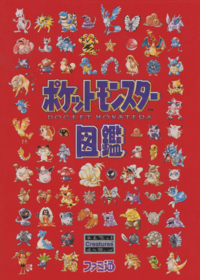An Illustrated Book of POCKET MONSTERS
From Bulbapedia, the community-driven Pokémon encyclopedia.
Jump to navigationJump to search

|
The subject of this article has no official English name. The name currently in use is a fan translation of the Japanese name. |
| 'Pocket Monsters Encyclopedia' | |
|---|---|

| |
| ISBN: | 4893664948 |
| Published: | April 5, 1996[1] |
| Publisher: | Famitsu |
| Author: | Creatures, Inc. |
(Japanese: ポケットモンスター図鑑 Pocket Monsters Encyclopedia) is a Japanese Pokémon illustrated guidebook that was released in April 1996, shortly after the release of Pokémon Red and Green, the first Pokémon games. It was produced by Creatures, Inc. and published by Famitsu.
The book includes illustrations of the Pokémon, as well as biological information about Pokémon and their habitats.
Title
The word 図鑑 zukan in this book's title refers to an illustrated reference book or a field guide. It is normally localized as Pokédex in English Pokémon media, especially ポケモン図鑑 (Pokémon Zukan).
Trivia
- In the lore provided by this book, it is described how Pokémon study was started by a 16th century French author named "Baron Tajirin". This character is named after Pokémon's creator, Satoshi Tajiri. Later in the introduction, it is said that a certain "Professor Nishinomori" was the father of Japanese Pokémon study, "Nishinomori" being a combination of the names of Koji Nishino and Ken Sugimori, both of whom played a key role in the development of Pokémon Red and Green.
- The introduction states that in Baron Tajirin's time only 30 Pokémon had been discovered. This is likely a reference to how, when developing Pokémon Red and Green, Satoshi Tajiri thought the Game Boy carts would only have room for 30 Pokémon, which was described in Tajiri's biographical manga.
- The fact that researchers have been arguing over Bulbasaur's classification for six years appears to be a nod to how Pokémon Red and Green took six years to develop.
- Charmander's entry describes how smokers use its flame's tail to light up their cigarette, something which was later shown off in a set of playing cards illustrated by Kagemaru Himeno and published in Corocoro Comics in late 1996.
- In Showdown at Dark City, the Pokédex mentions that Electabuzz and Scyther can both distinguish colors, and that they are enraged by the color red, details which were only seen in this book.
- Snorlax's entry contains an overt reference to Koji Nishino, as it describes how it got its Japanese name because it is capable of digesting moldy food. Indeed, "Kabi" is the Japanese word for mold, and Snorlax got its Japanese name "Kabigon" because it is a caricature of Nishino, who was said to eat pretty much anything he found, even if it was moldy.
- In Squirtle's entry, its habitat is described as unknown, perhaps because starter Pokémon can't be found in the wild. As for its "long neck", it has never been seen, but was still mentioned a handful of times across the series, such as in its Pokémon FireRed and Pokémon Sword Pokédex entries, and in Here Comes the Squirtle Squad.
- In Oddish's entry, it is given the nickname "Walkimendes", which is a pun on Archimedes, a Greek philosopher. In Japanese, this nickname also breaks down to "alki-men-desu," which translates into "We are walking men", which is fitting given Oddish's status as a walking plant.
- The entry for Kangaskhan refers to female Kangaskhan only, implying the existence of male Kangaskhan.
- The nickname "gangster of the sea" in Tentacruel's entry was only ever mentioned in the anime, by Ash's Pokedex in Tentacool & Tentacruel.
- As mentioned in Doduo's entry, this Pokémon does have wings, though they are extremely small, much like real-life kiwi birds. They were only referenced in its Yellow and Let's Go Pokédex entries.
- The short story mentioned in Kadabra's entry, "The Transformation", is an overt reference to Franz Kafka's "The Metamorphosis", in which a man wakes up one morning, only to realize that he's turned into a giant insect. This entry is also interesting, in that it describes what happened to the little boy as being fiction, whereas the in-game Pokédex entries tell it as if it really happened.
- In Moltres' entry, the idea of drinking phoenix blood to gain immortality isn't taken from any real-life myth, but is rather an homage to "Phoenix", a manga series by the legendary Osamu Tezuka.
- The entry for members of the Nidoran lines makes direct reference to Nidoran♀'s ability to produce Eggs, and Nidorina's inability to do so. This is consistent to Nidorina and Nidoqueen being unable to breed ever since the breeding mechanic was introduced in Pokémon Gold and Silver (which would be released years later). Baby Nidoran are also mentioned, and they were later seen on a 1997 ad for Pokémon Battoen.
- According to an illustration, Golduck is the fastest swimmer of the Kanto Pokémon, reaching speeds above 90 kilometres per hour. Additionally, Dewgong's swim speed is somewhere between 30 km/h and 60 km/h.
- During the entries for Pokémon which evolve through trade evolution, it is mentioned that researchers are not certain what could be triggering these Pokémon's evolution, implying that during the events of Pokémon Red and Green, trade evolution is a phenomenon not described or documented yet by science. The same thing also happens for Pokémon which evolve by evolutionary stone, with the given Pokémon's description only making note that its evolution appears to require "a special stone".
External links
- DidYouKnowGaming? video covering the book's contents (part 1)
- DidYouKnowGaming? (part 2)
- DidYouKnowGaming? (part 3)
- Blogspot article covering the book (Japanese)
References
- ↑ インドぞうを深追いするな: 裏設定の宝庫『ポケットモンスター図鑑』 (Japanese)
| This book-related article is a stub. You can help Bulbapedia by expanding it. |

|
This book article is part of Project Merchandise, a Bulbapedia project that aims to write comprehensive articles on all Pokémon toys, dolls, books, and collectible merchandise. |